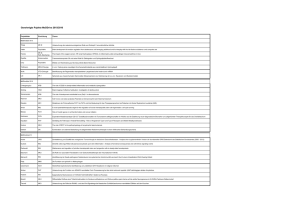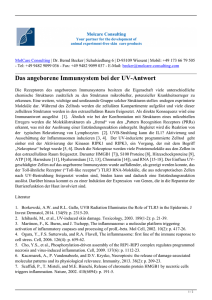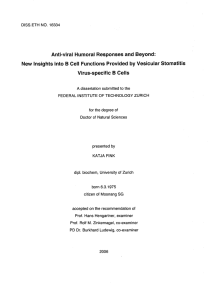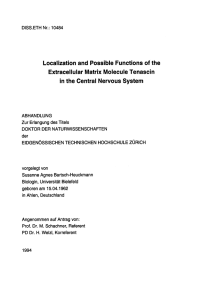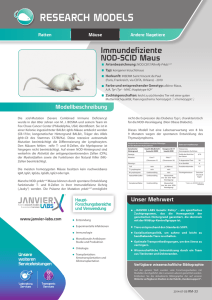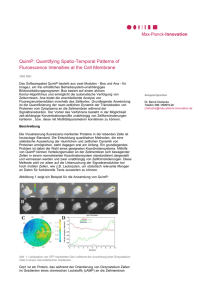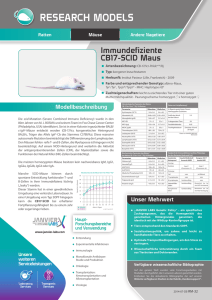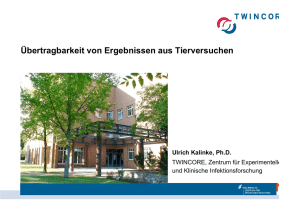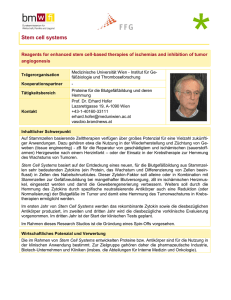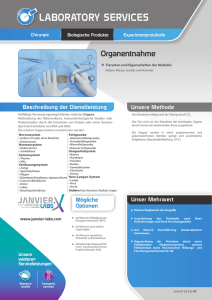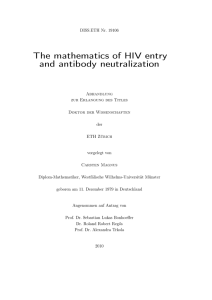analysisof anti-vesicularstomatitisvirus - ETH E
Werbung
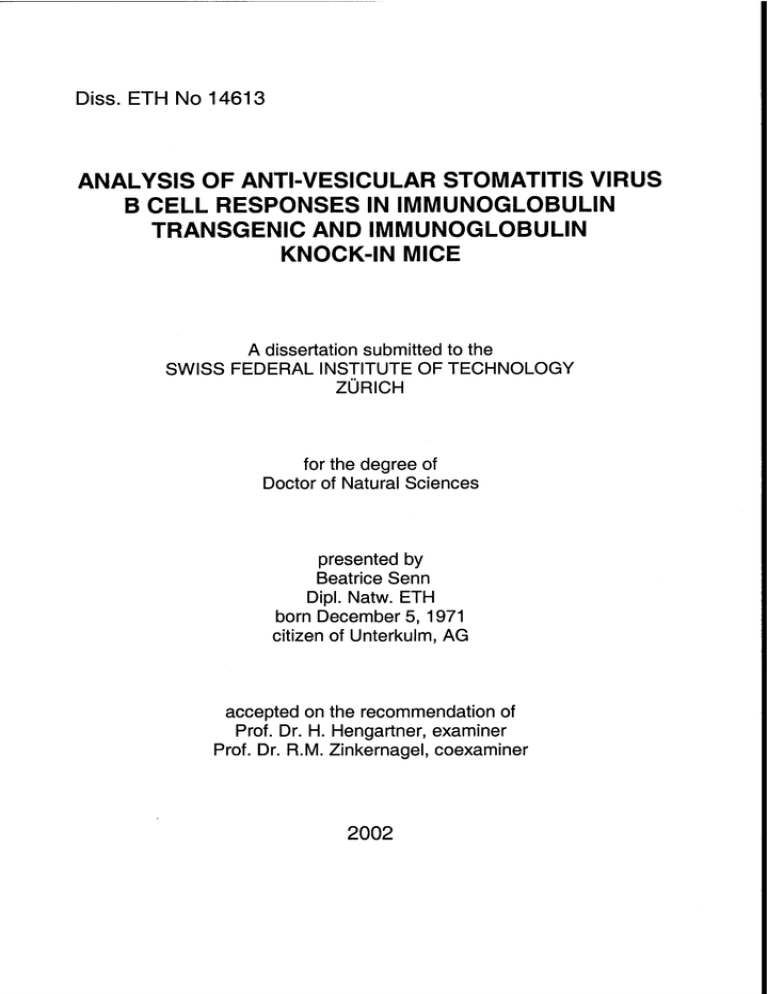
Diss. ETH No 14613 ANALYSISOF ANTI-VESICULARSTOMATITISVIRUS B CELL RESPONSES IN IMMUNOGLOBULIN TRANSGENICAND IMMUNOGLOBULIN KNOCK-IN MICE A dissertation submittedto the SWISS FEDERALINSTITUTEOF TECHNOLOGY ZÜRICH for the degree of Doctorof Natural Sciences presented by Beatrice Senn Dipl. Natw. ETH born December 5,1971 Citizen of Unterkulm, AG accepted on the recommendationof Prof. Dr. H. Hengartner, examiner Prof. Dr. R.M. Zinkernagel, coexaminer 2002 Summary 1 Summary The total numberof different B cell receptors in an intact immune system is immense and the frequency of B cells expressing a receptor with discrete antigen specificity is extremely low. This makes it very difficult, even impossible, to track the fate of a Single B cell or even a small subpopulation of B cells. With the use of transgene technology, transgenic mice could be generated where the great majority of B cells express a Single antibodyspecificity.Using these transgenic mice it became possible to follow a distinct B cell population, as the B cell population was rendered monoclonalor at least oligoclonal. Studies using transgenic mice have brought crucial insights into various aspects of and immunoregulation, such as control of allelic exclusion, immunological tolerance, in their are limited B cells antiviral responses. However, these transgenic very can be infiuenced because gene expression Immunoglobulin developmental capacity to various degrees by the endogenous Immunoglobulin loci. In addition, an important B cells to limiting factor of such BCR transgenic mice is the inability of the transgenicmaturation. undergo terminal differentiation including isotype class switch and affinity In order to circumvent these restrictions, gene targeting has been successfully employed to generate Immunoglobulin (Ig) knock-in mice. In this way, the Ig gene of interest is inserted into its natural position in the genome by homologous recombination and under these conditions the transgenic B cells can terminally differentiate with the ability to perform isotype class switch and to accumulate somatic hypermutations. but thus Up until now, a few different transgenic knock-in mice have been generatedthat would far no gene-targeted Ig knock-in mouse has been successfully produced immune an antiviral response. We allow one to study B cell development during therefore generated an Ig knock-in mouse strain that expresses the VH-regions from the cytopathic vesicular Stomatitis virus (VSV) serotype Indiana (IND) neutralizing antibody V110, called TgH(VMO). The rearranged VH-region, together with the Ig genuine promoter,was used to replace one DH and all JH elements of the germline eliminated viruses are locus by homologous recombination. As cytopathic mainly animal model should of this the action antibodies, provide an through neutralizing ideal system to study antiviral immune responses. The generation and preliminary characterization of the TgH(VMO) transgenic mouse is described in the first part of the results section. In addition, the production of specific antibodies to allow visualization of the transgenic B cells in vivo and in vitro is also described. This transgenic animal model will be of great interest for further studies of B cell immunology, including antiviral B cell responses, affinity maturation and B cell development. As we believe now B cell responses can be studied in a physiologicallyrelevant Situation without developmental limitations. part of the results section focuses mainly on B cell diversity. One of the remarkable properties of the adaptive immune system is the ability to produce a seemingly infinite variety of antigen-binding antibodies. During B cell development, B cell receptor diversity is created by the ordered rearrangement of V(D)J gene segments of the Immunoglobulin heavy and light chain gene loci together with the combinatorial pairing of the different heavy and light chains. Additional mechanisms such as receptor editing and receptor revision have also been implicated in modification and further diversification of the B cell repertoire. In addition, following The second Summary the variable region genes of antigen-specific somatic antibodies may undergo hypermutation and thus further increase the functional B cell repertoire. It is not presently understood how much of this enormous antibody repertoire is required to confer protection during an infection,tonor is it knowna mounting to which extend H-L chain pairing or hypermutation contribute L-chain how much it is also unclear impact protective B cell response. Furthermore, infections. variability has on the protective capacity of antibodies against pathogen To address these issues we analyzed antigen-specific immunoglobulin responses in mice exclusively expressing a transgenic n-chain of a VSV-IND neutralizingantibody The data indicates that (T11|iMT) in combination with endogenous light chains. combinatorial light chain variability alone can create a functional antibody repertoire that is sufficiently complex to cope with various antigenic challenges, including of poliovirus (PV) and Salmonella typhi porins, and to control a diverse rängeand pathogen infections like lymphocytic choriomeningitis virus (LCMV), VSV-IND antigen-dependant Stimulation, VSV-NJ. Zusammenfassung 2 Zusammenfassung produzierender Zellen im Immunsystem ist immens. Die Zahl von B-Zellen, die eine bestimmte Antigenspezifitätaufweisen, ist hingegen verschwindend klein. Deshalb war es lange unmöglich, eine spezifische BDie Anzahl unterschiedlicher Antikörper Beispiel während einer Virusinfektion, zu verfolgen. Mit Hilfe der Transgentechnologie wurde es möglich, eine Gruppe von B-Zellen zu identifiziem, da praktisch alle B-Zellen im transgenen Mäuse, Organismus ein und dieselbe Spezifität aufweisen.Solche B-Zell-transgenen im Genom bei denen die Erbinformation für einen vorgefertigten Antikörper irgendwo plaziert wurde, brachten einen enormen Beitrag zum Verständnis von verschiedenen der Allelischen Exklusion immunregulatorischen Aspekten wie deralsKontrolle einer Antikörperspezifität auf einer (Verhinderung der Expression von mehr Toleranz (Differenzierung zwischen Eigen einzigen B-Zelle), der immunologischen und Fremd) sowie der frühen Antikörperantwort gegen Viren. Die B-Zellen dieser Tiere hatten jedoch beträchtliche Einschränkungen, sie konnten einerseits ihre Effektorfunktion (durch Isotypenwechsel) nicht ändern und waren deshalb im es Reifungsprozess und der Lebensdauer stark eingeschränkt. Andererseits war durch diesen Tieren auch unmöglich, die Affinität des transgenen B-Zell-Rezeptors Zelle oder eine kleine Untergruppe von B-Zellen, zum Akkumulation von SomatischenMutationen zu erhöhen. Um diesen Nachteil zu umgehen, wurde von der kürzlich entwickelten Methode Rekombination gebrauch gemacht, welche transgene Tiere mittelsundhomologer somit antigenspezifische erzeugt. Diese bringt den Vorteil, dass die variable sondern im Genom nicht mehr wird, genau dorthin plaziert irgendwo Region von verschieden durch Zusammenbringen eingeführt wird, wo sie natürlicherweise Segmenten entsteht. Somit ist eine ungehinderte Entwicklung bis hin zum Gedächtnis-Zell-Status, inklusive Akkumulation von somatischen Hypermutationen und Isotypenklassenwechsel, gewährleistet. Bis jetzt wurde noch keine Studie durchgeführt, in der solche durch homologe Rekombination entstandenen transgenen Mäuse zur Untersuchung einer antiviralen Immunantwort verwendet wurden. Deshalb wurde eine solche Maus generiert, deren B-Zell-Rezeptor Stomatitis Virus ist. Da zytopathische spezifisch für das zytopathische Vesikuläre Viren neben Interferonen hauptsächlich durch die B-Zell-Antwort bekämpft werden, bietet dieser Modellorganismus ein ideales System zum Studium der antiviralen BZell-Antwort. Im ersten Resultateteil dieser Dissertation sind neben der Generation dieser Maus und deren ersten Charakterisierung auch die Herstellung von Reagenzien, die der Visualisierung der transgenen B Zellen dienen, beschrieben. Dieses Mausmodell wird für weitere Untersuchungenvon enormer Bedeutung sein, da es zum ersten Mal die Untersuchungder B-Zell-Antwort in einem physiologisch relevanten (antiviralen) System ohne Entwicklungseinschränkungen erlaubt. Der Schwerpunkt des zweiten Resultateteils ist die extrem hohe Antikörpervielfalt des Immunsystems. Diese Antikörpervielfalt entsteht während der B-Zell-Entwicklung durch einen geordneten Prozess, bei dem V(D)J Gen-Segmente zufällig zusammengefügt werden und so die Antigenbindungsstelle definieren. Die Variabilität wird durch kombinatorisches Zusammenfügen von variablen Regionen von schwerer und leichter Kette, sowie durch das Einbringenvon Punktmutationen in Zusammenfassung oder gar durch einen gezielten Austausch von einzelnen V Segmenten zusätzlich erhöht. Bis jetzt war noch nicht bekannt, inwieweit das zufällige Zusammenfügen einer schweren mit einer leichten Kette oder das Einbringen von Punktmutationen in der schweren Kette zum Schutz gegen eine virale Infektion beitragen kann. Um dieses nur eine zu untersuchen, machten wir Gebrauch von einer transgenen Maus, die Virus gerichtet, in ganz spezifische schwere Kette, gegen das VesikuläreStomatitis Ketten besitzt. In dieser von leichten Kombination mit einer uneingeschränkten Zahl Studie konnten wir zeigen, dass der Gebrauch unterschiedlicher leichter Ketten zusammen mit der vorgefertigten schweren Kette genügend Variablität erzeugen kann, um den Organisums gegen Infektionen mit den unterschiedlichsten Pathogenen schützen zu können. die variable Region
